Submitted by Gitie on 23 September, 2010 - 16:00
I love your website! I've been a huge fan of birds all my life and have friends who are bird rehabilitators. Your stories about birds are charming. My readers know how much I love birds, and I'm sure they'd love to learn about your site! I have a Red-Tailed Hawk that I've befriended (by chasing away crows that were mobbing it). But what my readers know best are my stories of how Purple Finches nest on my balcony every year, just a foot from my window. In fact, I plan to post a video on YouTube of great footage I got of the babies exercising their flight muscles and nearly flying out of the nest before they were ready and will send you the details shortly.
-- Resa Nelson, Author,
'Our Lady Of The Absolute' - out now!
http://resanelson.com/september-28-special-offer/
Each year Purple Finches nest one foot from my window.
In each family, one baby takes a leadership role and does something unique.
|
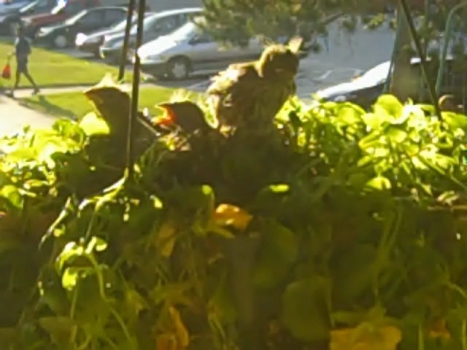
In this family, the baby leader perches on the edge of the nest.
Then...
|
|
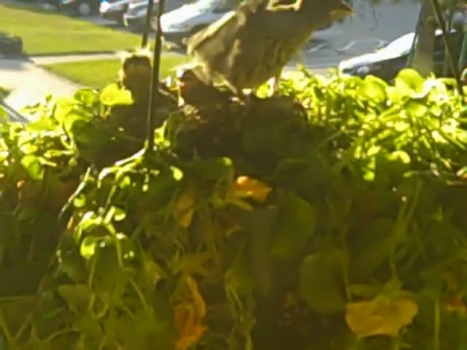
the perching baby exercises its flight muscles by flapping its wings.
It's two siblings watch...
|
|
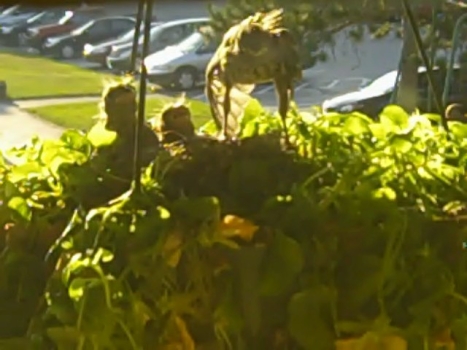
This is something I've never seen a baby Purple Finch do
before. It's stretching it's legs.
|
|
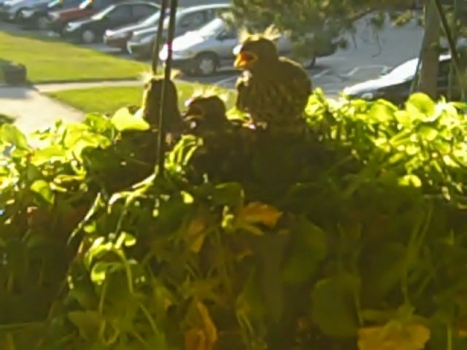
Notice the tufts of baby fuzz on the birds' heads. Here
it's easier to see the markings and colouring of the baby's breast.
|
|
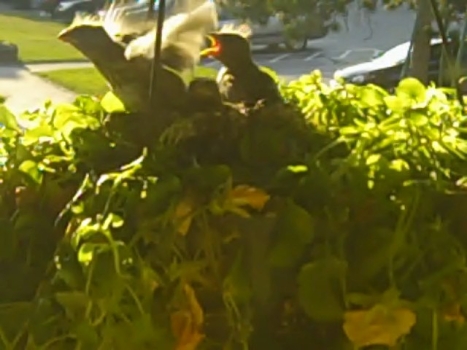
The dominant baby has returned to the nest.
One of its siblings decides to try its wings.
|
|
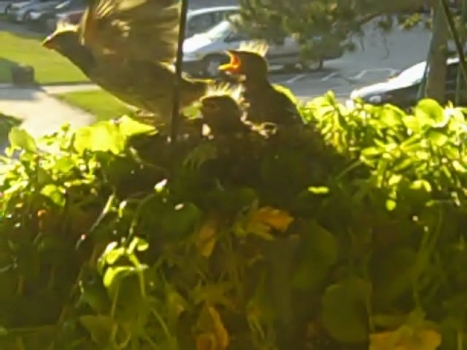
...And the were a little more startling than expected.
Tomorrow I'll post the video so you can see what happens next!
|
Click here for Part 2

Submitted by Gitie on 10 July, 2010 - 00:06
Reader Claire Muskus sent us these gorgeous pictures of baby red-talied hawks. The chicks look so cute: here is Claire's story:
"We have a pair of red-tailed hawks that nest each year on our 5th floor ledge. Usually mid-March, the mom starts her annual ‘house cleaning’ then commences to ‘just sit’. This year there were 3 eggs; all survived. Last year the same number were in the nest, but only two survived. Several years ago, one of the ‘youngins’ fell out of a tree that was near the bldg. Because its wings weren’t strong enough to make it fly back up to the nest, it wandered back and forth on the wall with its mother was dutifully watching and calling to it from across the street and often making low sweeps over it. Some agricultural students from Trinity College were called in to try to capture it, which they were able to, somehow. I had the good fortune of actually seeing the hawk ‘up close and personal’. It certainly was a magnificent, yet scary example of power. I couldn’t believe the length of its talons – to gaze into its eyes was unnerving at best; it was if it could look through to your soul and beyond. ‘Determination’ was the name of the game because somehow the bird escaped again, this time crossing the road and found its way into the bushes at the Bushnell; the DEP (Dept. of Environmental Protection) was contacted. They found the bird, put a large towel over its head, brought it into the building, up the elevator (wished I’d been on that ride up – can you ever imagine getting on and seeing this ‘thing’ sitting on someone’s arm covered with a towel???) to the 5th floor, opened a casement window and put it back on the ledge where it was supposed to be. "
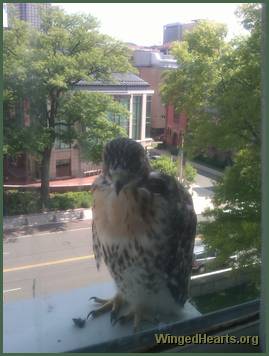 |
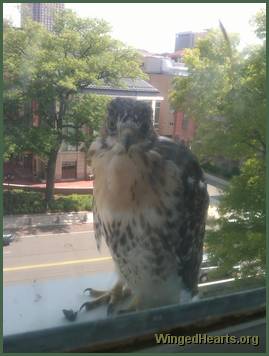 |

Submitted by Gitie on 30 June, 2010 - 00:09
What should one do when one finds a baby bird and its parents seem nowhere around?

The answer depends on many factors and is not as simple as we would like it to be. Much depends upon the age/stage of the chick, what type of chick it is and the state of the individual bird and whether it is really orphaned or just appears so.
Here are some quick tips:

Submitted by Gitie on 3 June, 2010 - 17:17
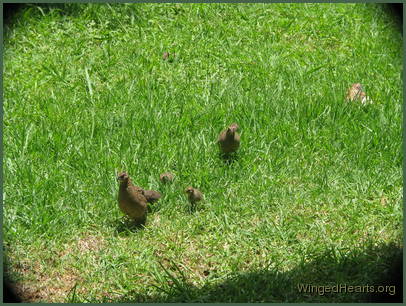 For the last two days I've been telling you about noisy-miners. Now the miners are considered to be one of the more aggressive birds in the country. They work in teams and families and can stand up to big birds like the crows and gang up on any bird who won't give into their demands (e.g the friarbirds).
For the last two days I've been telling you about noisy-miners. Now the miners are considered to be one of the more aggressive birds in the country. They work in teams and families and can stand up to big birds like the crows and gang up on any bird who won't give into their demands (e.g the friarbirds).
Quails on the other hand are considered to be very timid and extremely vulnerable. They have been easy targets for shooters and fall prey to predatory birds.
So imagine our surprise when a family of quails walked down from the grassy paddock into our backyard for a grand tour of the human habitat. The adults were so confident and proud of their little chicks who were barely days old. They inspected the bird baths, walked along the garden, checked out the undergrowth beneath the bushes, pausing every now and then to point significant items of interest to their young flock. They came right up to the back door and took a good long look inside. By the time I grabbed the camera and focussed through the glass, it was time for them to leave, so some of the shots

Submitted by Gitie on 31 May, 2010 - 23:42
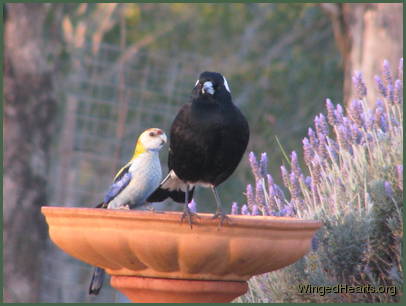 Different species of birds have different needs regarding access to water and plants. The extent and diversity of their territories and feeding habits influence their visiting times. But even more interestingly the ability to negotiate their visiting and access rights with other birds who are considered by them as the rightful owners of the territory has a major impact on their movements.
Different species of birds have different needs regarding access to water and plants. The extent and diversity of their territories and feeding habits influence their visiting times. But even more interestingly the ability to negotiate their visiting and access rights with other birds who are considered by them as the rightful owners of the territory has a major impact on their movements.
Click here to read more.

Pages










 For the last two days I've been telling you about
For the last two days I've been telling you about  Different species of birds have different needs regarding access to water and plants. The extent and diversity of their territories and feeding habits influence their visiting times. But even more interestingly the ability to negotiate their visiting and access rights with other birds who are considered by them as the rightful owners of the territory has a major impact on their movements.
Different species of birds have different needs regarding access to water and plants. The extent and diversity of their territories and feeding habits influence their visiting times. But even more interestingly the ability to negotiate their visiting and access rights with other birds who are considered by them as the rightful owners of the territory has a major impact on their movements.



